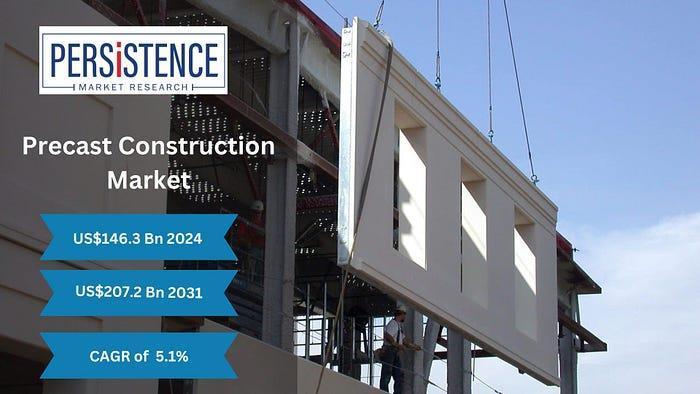Precast Construction Market in India: A Rising Trend in Infrastructure Development

India is witnessing a significant transformation in its construction sector, driven by the increasing adoption of precast construction methods. Precast construction, involving the use of prefabricated components produced in a controlled environment, is gaining momentum due to its numerous advantages over traditional construction techniques. This blog explores the growth drivers, benefits, challenges, and future prospects of the precast construction market in India.
The global market for precast construction is estimated to value at US$ 207.2 Bn by the end of 2031 from US$ 146.3 Bn in 2024. The market is estimated to expand at a CAGR of 5.1% during the forecast period from 2024 to 2031.
Growth Drivers
Several factors are contributing to the growth of the precast construction market in India:
1. Urbanization and Infrastructure Development
India’s rapid urbanization has led to an increased demand for residential, commercial, and industrial spaces. To accommodate this growth, the government has launched several initiatives like Smart Cities Mission and Housing for All, which have created a surge in construction activities. Precast construction, with its ability to expedite project timelines, has become a preferred choice for many developers.
2. Government Initiatives
Government policies and initiatives play a crucial role in promoting precast construction. The introduction of the Real Estate (Regulation and Development) Act (RERA) and the Pradhan Mantri Awas Yojana (PMAY) have emphasized timely delivery and quality construction, making precast methods more attractive.
3. Cost Efficiency
Precast construction offers significant cost advantages. By reducing labor costs, minimizing material wastage, and shortening project durations, developers can achieve substantial savings. Additionally, the ability to reuse molds for multiple projects further enhances cost efficiency.
4. Quality and Durability
Precast components are manufactured in controlled environments, ensuring high quality and uniformity. This results in structures that are more durable and require less maintenance over time, providing long-term benefits to both developers and occupants.
Benefits of Precast Construction
1. Speed of Construction
One of the most significant advantages of precast construction is the speed at which projects can be completed. Since components are manufactured off-site and assembled on-site, construction timelines are significantly reduced, allowing for faster project delivery.
2. Enhanced Safety
Precast construction reduces the need for extensive on-site labor, minimizing the risk of accidents and improving overall safety. The controlled manufacturing environment also ensures adherence to safety standards and regulations.
3. Sustainability
Precast construction is inherently sustainable. The use of prefabricated components reduces construction waste, and the controlled production process allows for better resource management. Additionally, precast structures are often more energyefficient, contributing to lower carbon footprints.
4. Flexibility and Versatility
Precast components can be customized to meet specific design requirements, offering flexibility in architectural design. This versatility makes precast construction suitable for a wide range of applications, including residential buildings, commercial complexes, industrial facilities, and infrastructure projects.
Challenges
Despite its numerous benefits, the precast construction market in India faces several challenges:
1. High Initial Investment
Setting up a precast manufacturing facility requires significant capital investment. This can be a barrier for small and medium-sized construction companies looking to adopt precast methods.
2. Skilled Labor Shortage
The adoption of precast construction requires a skilled workforce proficient in handling precast components and assembling them on-site. The shortage of such skilled labor can hinder the growth of the market.
3. Logistical Challenges
Transporting large precast components to construction sites can be challenging, especially in urban areas with traffic congestion and limited access. Efficient logistics and transportation planning are crucial for the success of precast projects.
4. Awareness and Acceptance
While the benefits of precast construction are well-documented, there is still a lack of awareness and acceptance among some stakeholders in the construction industry. Educating developers, architects, and contractors about the advantages of precast methods is essential for wider adoption.
Future Prospects
The future of the precast construction market in India looks promising. With increasing urbanization, government support, and a growing emphasis on sustainable and efficient construction practices, the demand for precast methods is expected to rise. Innovations in precast technology, coupled with improved logistics and training programs, will further drive the growth of the market.
1. Technological Advancements
Advancements in precast technology, such as the use of high-performance concrete and innovative design techniques, will enhance the quality and efficiency of precast components. These innovations will make precast construction even more attractive to developers.
2. Expansion of Manufacturing Facilities
To meet the growing demand, several companies are investing in new precast manufacturing facilities across India. This expansion will increase the availability of precast components and reduce project lead times.
3. Increased Collaboration
Collaboration between government bodies, industry associations, and private companies will play a crucial role in promoting precast construction. Joint efforts to address challenges, improve standards, and create awareness will drive the market forward.
4. Sustainable Development
As sustainability becomes a key focus in the construction industry, the demand for precast methods will continue to grow. Precast construction’s ability to minimize waste, reduce energy consumption, and create durable structures aligns well with the goals of sustainable development.
Conclusion
The precast construction market in India is on the cusp of significant growth, driven by urbanization, government initiatives, cost efficiency, and a growing emphasis on quality and sustainability. While challenges remain, the future looks bright with technological advancements, increased manufacturing capacity, and collaborative efforts. As the construction landscape evolves, precast construction will play a pivotal role in shaping India’s infrastructure development.
By embracing precast construction, India can achieve faster, safer, and more sustainable development, paving the way for a brighter and more efficient future.
